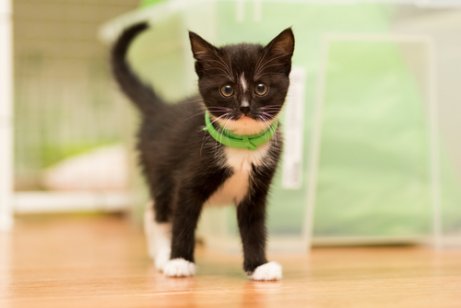Taking Care of a Kitten: what you need to know

Maybe you found a kitten on the street with no mom in sight, or maybe you just adopted one. In this article, you can read everything you need to know about taking care of a kitten.
Tips for taking care of an orphaned kitten
Caring for a kitten that’s less than three weeks old is a challenge. Kittens this young require lots of attention. With dedication, a lot of love, and gentleness, these babies can survive even without having a mama to take care of them.
1. Maintain their body temperature
When kittens are born, they spend all day next to their mother’s belly. In addition to feeding, this closeness allows them to stay warm. Therefore, you need to give very young kittens everything they need to keep their body temperatures up. This is especially true at night because these animals aren’t able to regulate their own body heat yet.
You can wrap the kitten in a blanket or use a thermal pillow. You could also use other pets as babysitters to provide them with warmth (and also affection). Otherwise, if the kitten keeps crying or trembling and their paws are cold, place her in your lap.

2. Don’t give them normal milk
A very common mistake when people find a kitten is to heat up milk from the fridge and then give it to their cats. This liquid is not good for their health because it doesn’t contain any necessary nutrients and can even cause stomach problems such as diarrhea or vomiting.
In pet stores, you can buy special powdered formula milk for your cat. This replaces the mother’s milk. However, if you can’t get formula, you can give them warm water with a syringe. Milk should be given with a bottle and heated to 37 degrees Celcius. Remember, babies eat every three hours!
3. Teach them to how to use the litter box
Among the main tasks to do when taking care of a kitten that has been orphaned, is teaching them to relieve themselves. A mother cat would stimulate their baby by licking their belly and surrounding areas. In the case the mother isn’t around, you can wet a cotton ball and rub it on the cat’s genitals and surrounding areas after every feeding session.
Another thing you should do is clean the kitten like a mother would. You can use a cloth dipped in warm water. Rub it through their fur very carefully. Afterward, dry the kitten well so they don’t get sicky.
Tips for taking care of a kitten that has been weaned
After four weeks of age, kittens stop drinking breast milk. They already opened their eyes and know how to relieve themselves. However, they still have a lot to learn. If you have adopted an already weaned baby cat, follow the tips below in order to know what it’s like taking care of a kitten:
1. Give them special food
In pet stores, you can buy kitten food. This food is softer than adult food and contains other types of nutrients and ingredients. They also are suitable for the size for their small mouths.
Be patient and gradually give them food. At first, they won’t know how to eat or chew. You may have to hand feed them small bits of food, one at a time. Then, the kitten will get used to eating alone.
2. Take them to the vet
It doesn’t matter if you’ve adopted the cat from a shelter or if they’re one kitten from your neighbor’s cat’s litter or one you found it on the street. All cats need to visit the vet when they are young.

The veterinarian will take a look at the cat, give them all the vaccines they need, and give you some advice about their care and feeding. With this advice, you can make sure the animal doesn’t get sick and will live for many years. In addition, you can take this opportunity to ask the vet about the kitten’s breed (Siamese, Persian, etc.) and how to care for them.
3. Avoid home hazards
If you’ve never had a pet, much less a cat, your house might not be suitable for animals. Don’t worry though. You can improve it with just a few changes.
First, no opened windows or access to terraces or balconies. Until the kitten gets used to walking alone, this means monitoring everywhere they go.
Another very important issue is hiding electrical cords, small objects (such as pens), medications, and cleaning supplies. Cats are very skilled and can open doors and drawers. Make sure everything is very secure.
Close the lid of the garbage can and toilet. Don’t leave the bathroom door open or any room you don’t want the kitten to go enter. Also, pay attention to what kinds of plants you have in your home because some plants can be toxic to cats.
Taking care of a kitten is not a simple task, but it’s not impossible. You just have to give the animal what they need and make sure they don’t get hurt or destroy everything in your house.
Maybe you found a kitten on the street with no mom in sight, or maybe you just adopted one. In this article, you can read everything you need to know about taking care of a kitten.
Tips for taking care of an orphaned kitten
Caring for a kitten that’s less than three weeks old is a challenge. Kittens this young require lots of attention. With dedication, a lot of love, and gentleness, these babies can survive even without having a mama to take care of them.
1. Maintain their body temperature
When kittens are born, they spend all day next to their mother’s belly. In addition to feeding, this closeness allows them to stay warm. Therefore, you need to give very young kittens everything they need to keep their body temperatures up. This is especially true at night because these animals aren’t able to regulate their own body heat yet.
You can wrap the kitten in a blanket or use a thermal pillow. You could also use other pets as babysitters to provide them with warmth (and also affection). Otherwise, if the kitten keeps crying or trembling and their paws are cold, place her in your lap.

2. Don’t give them normal milk
A very common mistake when people find a kitten is to heat up milk from the fridge and then give it to their cats. This liquid is not good for their health because it doesn’t contain any necessary nutrients and can even cause stomach problems such as diarrhea or vomiting.
In pet stores, you can buy special powdered formula milk for your cat. This replaces the mother’s milk. However, if you can’t get formula, you can give them warm water with a syringe. Milk should be given with a bottle and heated to 37 degrees Celcius. Remember, babies eat every three hours!
3. Teach them to how to use the litter box
Among the main tasks to do when taking care of a kitten that has been orphaned, is teaching them to relieve themselves. A mother cat would stimulate their baby by licking their belly and surrounding areas. In the case the mother isn’t around, you can wet a cotton ball and rub it on the cat’s genitals and surrounding areas after every feeding session.
Another thing you should do is clean the kitten like a mother would. You can use a cloth dipped in warm water. Rub it through their fur very carefully. Afterward, dry the kitten well so they don’t get sicky.
Tips for taking care of a kitten that has been weaned
After four weeks of age, kittens stop drinking breast milk. They already opened their eyes and know how to relieve themselves. However, they still have a lot to learn. If you have adopted an already weaned baby cat, follow the tips below in order to know what it’s like taking care of a kitten:
1. Give them special food
In pet stores, you can buy kitten food. This food is softer than adult food and contains other types of nutrients and ingredients. They also are suitable for the size for their small mouths.
Be patient and gradually give them food. At first, they won’t know how to eat or chew. You may have to hand feed them small bits of food, one at a time. Then, the kitten will get used to eating alone.
2. Take them to the vet
It doesn’t matter if you’ve adopted the cat from a shelter or if they’re one kitten from your neighbor’s cat’s litter or one you found it on the street. All cats need to visit the vet when they are young.

The veterinarian will take a look at the cat, give them all the vaccines they need, and give you some advice about their care and feeding. With this advice, you can make sure the animal doesn’t get sick and will live for many years. In addition, you can take this opportunity to ask the vet about the kitten’s breed (Siamese, Persian, etc.) and how to care for them.
3. Avoid home hazards
If you’ve never had a pet, much less a cat, your house might not be suitable for animals. Don’t worry though. You can improve it with just a few changes.
First, no opened windows or access to terraces or balconies. Until the kitten gets used to walking alone, this means monitoring everywhere they go.
Another very important issue is hiding electrical cords, small objects (such as pens), medications, and cleaning supplies. Cats are very skilled and can open doors and drawers. Make sure everything is very secure.
Close the lid of the garbage can and toilet. Don’t leave the bathroom door open or any room you don’t want the kitten to go enter. Also, pay attention to what kinds of plants you have in your home because some plants can be toxic to cats.
Taking care of a kitten is not a simple task, but it’s not impossible. You just have to give the animal what they need and make sure they don’t get hurt or destroy everything in your house.
All cited sources were thoroughly reviewed by our team to ensure their quality, reliability, currency, and validity. The bibliography of this article was considered reliable and of academic or scientific accuracy.
- Angulo, S.M. (2011). Reproducción canina y felina y neonatología. Manuales clínicos por especialidades. Editorial Servet. https://bit.ly/3H6wiVz
- Brusa, M. (2014) Compendio de enfermedades de los caninos y felinos domésticos. Libros de Cátedra. Universidad Nacional de La Plata. https://www.lareferencia.info/vufind/Record/AR_054ecdbbc86d8225deff9fec25883726
- Hemmings, C. (2016). The importance of good nutrition in growing puppies and kittens. The Veterinary Nurse, 7(8). https://www.magonlinelibrary.com/doi/abs/10.12968/vetn.2016.7.8.450
- Johnson, C. A., & Casal, M. L. (2012). Neonatal resuscitation: canine and feline. Management of Pregnant and Neonatal Dogs, Cats, and Exotic Pets, 77-92. https://onlinelibrary.wiley.com/doi/abs/10.1002/9781118997215.ch6
- Lawler, D. F. (2008). Neonatal and pediatric care of the puppy and kitten. Theriogenology, 70(3), 384-392. https://www.sciencedirect.com/science/article/abs/pii/S0093691X08002033
- Little, S. (2011). Feline pediatrics: how to treat the small and the sick. Compendium: Continuing Education For Veterinarians, 33, 1-6. https://pubmed.ncbi.nlm.nih.gov/21993989/
- Mugnier, A., Chastant, S., Saegerman, C., Gaillard, V., Grellet, A., & Mila, H. (2021). Management of low birth weight in canine and feline species: Breeder profiling. Animals, 11(10), 2953. https://www.mdpi.com/2076-2615/11/10/2953
- Oakwood Animal Hospital. (s.f.). When To Take a Cat To The Vet. https://www.oakwoodanimalhospital.com/site/blog/2021/12/15/take-cat-to-vet
- Restine, L., Buzhardt, L. & Ward, E. (s.f.). Recommendations for New Kitten Owners. VCA Animal Hospitals. https://vcahospitals.com/know-your-pet/vaccination-are-booster-vaccines-necessary-for-cats
- Rubio, A., Martínez Ávila, R., Guzmán Iturbe, H., Chávez Zapata, F., De la Colina, G., Salazar Guevara, J., Ramírez, I. A., Autrán de Morais, H., & Guerrero, J. (2018). Guías para la vacunación de perros (caninos) y gatos (felinos) en Perú. Revista de Investigaciones Veterinarias del Perú, 29(4), 1463-1474. http://www.scielo.org.pe/scielo.php?script=sci_arttext&pid=S1609-91172018000400043
-
Tizard I. R. (1998). Feline Immune System. Encyclopedia of Immunology, 892–895. https://www.ncbi.nlm.nih.gov/pmc/articles/PMC7149830/
- Veronesi, M. C., & Fusi, J. (2022). Feline neonatology: from birth to commencement of weaning–what to know for successful management. Journal of Feline Medicine and Surgery, 24(3), 232-242. https://pubmed.ncbi.nlm.nih.gov/35209772/
- Zambelli, D. (2012). Feline neonatal physiology, behavior, and socialization. Management of Pregnant and Neonatal Dogs, Cats, and Exotic Pets, 145-158. https://onlinelibrary.wiley.com/doi/abs/10.1002/9781118997215.ch9
- WebMD. (12 de julio de 2021). Weaning a Kitten From Mother’s Milk to Solid Food. FETCH. https://pets.webmd.com/cats/weaning-kitten
This text is provided for informational purposes only and does not replace consultation with a professional. If in doubt, consult your specialist.








